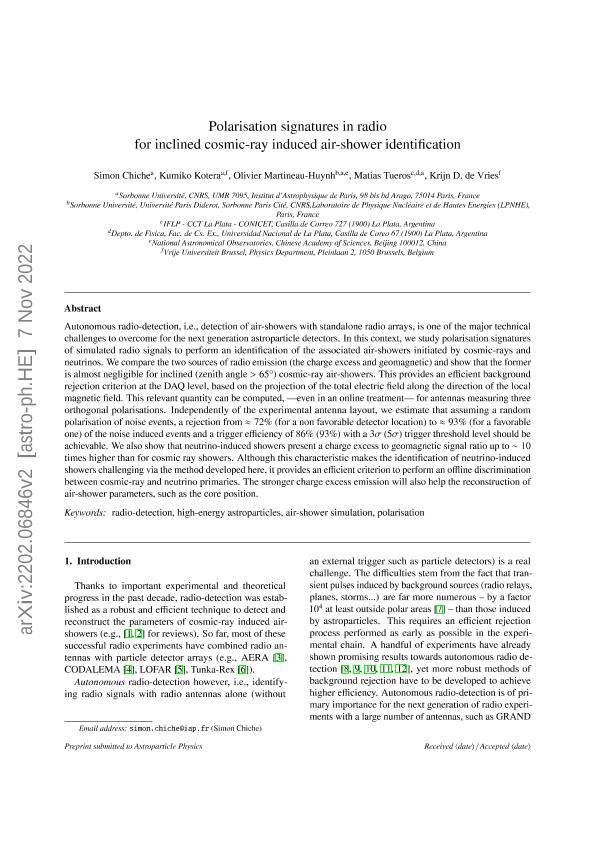Mostrar el registro sencillo del ítem
dc.contributor.author
Chiche, Simon
dc.contributor.author
Kotera, Kumiko
dc.contributor.author
Martineau Huynh, Olivier
dc.contributor.author
Tueros, Matias Jorge

dc.contributor.author
de Vries, Krijn D.
dc.date.available
2023-11-07T13:00:44Z
dc.date.issued
2022-06
dc.identifier.citation
Chiche, Simon; Kotera, Kumiko; Martineau Huynh, Olivier; Tueros, Matias Jorge; de Vries, Krijn D.; Polarisation signatures in radio for inclined cosmic-ray induced air-shower identification; Elsevier Science; Astroparticle Physics; 139; 6-2022; 102696-102716
dc.identifier.issn
0927-6505
dc.identifier.uri
http://hdl.handle.net/11336/217282
dc.description.abstract
Autonomous radio-detection, i.e., detection of air-showers with standalone radio arrays, is one of the major technical challenges to overcome for the next generation astroparticle detectors. In this context, we study polarisation signatures of simulated radio signals to perform an identification of the associated air-showers initiated by cosmic-rays and neutrinos. We compare the two sources of radio emission (the charge excess and geomagnetic) and show that the former is almost negligible for inclined (zenith angle >65°) cosmic-ray air-showers. This provides an efficient background rejection criterion at the DAQ level, based on the projection of the total electric field along the direction of the local magnetic field. This relevant quantity can be computed, — even in an online treatment — for antennas measuring three orthogonal polarisations. Independently of the experimental antenna layout, we estimate that assuming a random polarisation of noise events, a rejection from ≈72% (for a non favourable detector location) to ≈93% (for a favourable one) of the noise induced events and a trigger efficiency of 86% (93%) with a 3σ (5σ) trigger threshold level should be achievable. We also show that neutrino-induced showers present a charge excess to geomagnetic signal ratio up to ∼10 times higher than for cosmic ray showers. Although this characteristic makes the identification of neutrino-induced showers challenging via the method developed here, it provides an efficient criterion to perform an offline discrimination between cosmic-ray and neutrino primaries. The stronger charge excess emission will also help the reconstruction of air-shower parameters, such as the core position.
dc.format
application/pdf
dc.language.iso
eng
dc.publisher
Elsevier Science

dc.rights
info:eu-repo/semantics/openAccess
dc.rights.uri
https://creativecommons.org/licenses/by-nc-sa/2.5/ar/
dc.subject
AIR-SHOWER SIMULATION
dc.subject
HIGH-ENERGY ASTROPARTICLES
dc.subject
POLARISATION
dc.subject
RADIO-DETECTION
dc.subject.classification
Física de Partículas y Campos

dc.subject.classification
Ciencias Físicas

dc.subject.classification
CIENCIAS NATURALES Y EXACTAS

dc.title
Polarisation signatures in radio for inclined cosmic-ray induced air-shower identification
dc.type
info:eu-repo/semantics/article
dc.type
info:ar-repo/semantics/artículo
dc.type
info:eu-repo/semantics/publishedVersion
dc.date.updated
2023-11-06T15:26:11Z
dc.journal.volume
139
dc.journal.pagination
102696-102716
dc.journal.pais
Países Bajos

dc.journal.ciudad
Amsterdam
dc.description.fil
Fil: Chiche, Simon. Université Pierre et Marie Curie; Francia
dc.description.fil
Fil: Kotera, Kumiko. Vrije Unviversiteit Brussel; Bélgica. Université Pierre et Marie Curie; Francia
dc.description.fil
Fil: Martineau Huynh, Olivier. Université Pierre et Marie Curie; Francia
dc.description.fil
Fil: Tueros, Matias Jorge. Consejo Nacional de Investigaciones Científicas y Técnicas. Centro Científico Tecnológico Conicet - La Plata. Instituto de Física La Plata. Universidad Nacional de La Plata. Facultad de Ciencias Exactas. Instituto de Física La Plata; Argentina
dc.description.fil
Fil: de Vries, Krijn D.. Vrije Unviversiteit Brussel; Bélgica
dc.journal.title
Astroparticle Physics

dc.relation.alternativeid
info:eu-repo/semantics/altIdentifier/doi/http://dx.doi.org/10.1016/j.astropartphys.2022.102696
Archivos asociados
